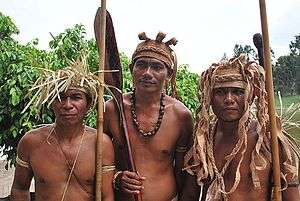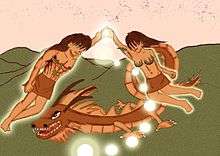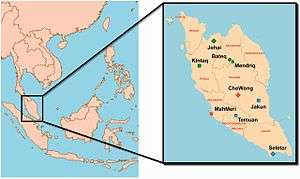Temuan people
 Temuan people in traditional clothing. | |
| Total population | |
|---|---|
| 19,343 (2010)[1] | |
| Regions with significant populations | |
|
| |
| Languages | |
| Temuan language, Malay language, Malaysian English | |
| Religion | |
| Ancestral worship (predominantly) and a significant population practice Christianity or Islam [2] | |
| Related ethnic groups | |
| Semelai people,[3] Malays |
The Temuan people (Temuan: Uwang/Eang Temuan, Malaysian: Orang Temuan) are a Proto-Malay ethnic group indigenous to western parts of Peninsular Malaysia. They can be found in the states of Selangor, Pahang, Johor, Negeri Sembilan and Malacca. The Temuans are classified as part of Orang Asli group according to the Malaysian government. They are also one of the largest (numbering to almost 30,000 people) and the most widespread of the Orang Asli ethnic groups.
They speak Temuan, an Austronesian language closely related to Malay. Like other indigenous tribes in Malaysia, most Temuans live in poverty.
Population
The changes in the population of the Temuan people in Malaysia:-
| Year | 1960[4] | 1965[4] | 1969[4] | 1974[4] | 1980[4] | 1991[5] | 1993[5] | 1996[4] | 2000[6] | 2003[6] | 2004[7] | 2010[1] |
|---|---|---|---|---|---|---|---|---|---|---|---|---|
| Population | 5,241 | 7,221 | 8,631 | 8,698 | 9,449 | 15,057 | 16,020 | 16,020 | 18,560 | 22,162 | 21,512 | 19,343 |
Flood legend

Thousands of years ago, many Temuan people died because they had committed "Celau" (the sins that angered god and their ancestors; as it is also called Talan in Semaq Beri language[8]). Their god has sent a "Celau" punishment in a form of a great flood which had drowned all the Temuan sinners that day. Only two of the Temuans, named Mamak and Inak Bungsuk survived that day by climbing at Eaglewood tree at Gunung Raja (Royal Mountain) located at the border of Selangor and Pahang state. There was a Temuan village over there named Kampung Orang Asli Pertak. Mamak and Inak Bungsuk survived because they had an enchanting mantra or spell to ease down the "Celau" storm.[9] Gunung Gajak (Gunung Rajah, Pahang, Malaysia) became the birth places and ancestral home of the Temuan tribe.[10]
Mamak Bungsuk (Adam) and Inak Bungsuk (Eve) are the Temuan analogues of Adam and Eve in the myth of the birth of humanity.
Language
The Temuans have their own language called the Temuan language or Bahasak Temuan. It is distinct but closely related to the Malay language spoken by their Malay neighbours. The Temuan language is a Malayan language spoken by the majority of the Temuan people. It is essentially a spoken language with several dialectal variation. Temuan is divided into two major dialects namely Belandas and Mantra which differs mostly in terms of phonology and also some of the vocabulary but still mutually intelligible to one another. Temuan is mostly written in the Latin alphabet although no standard orthography has been made.
Comparison between Belandas and Mantra dialects
Example of Temuan Belandas dialect: diak (he/she), hajak (only), kitak (we), tai (the end of sentence particle).
Example of Temuan Mantra dialect: dien (he/she), hajen (only), kiten (we), tea (the end of sentence particle).
Religion

A basic traditional Temuan belief is that their God and ancestors are always present with them, guarding their safety.
At the end of every year, the Temuans celebrate Aik Gayak Muyang (Ancestor Day in English). This celebration is to thank their God and ancestors for the crops they grow and for the peaceful life they have had.[11]
The Temuans believe they were placed on the earth (Tanah Tujuh) by Muyang (God) to be guardians of the rain forest and that if they fail in their sacred duty, the whole world will turn upside down and humanity will perish.[9] Each river, hill, stream, rock, tree and shrub is animated by a guardian spirit. Rivers are guarded by dragons (naga) and snakes (ular) which often cause mayhem if their homes are desecrated.
The Temuan’s culture reflects their belief in these nature spirits. Their animism takes the form of taboos, herbal remedies, ritual ceremonies and magic. They have dukun (healers) and a village bomoh (shaman) who, when in a trance state, communicates with the nature spirits. It is the shaman who leads the tribe in the annual sawai or sewang - an ancient earth healing ritual to honour their ancestors and appease the guardian spirits.[12]
Although today the Temuans mostly adhere to their animistic beliefs, the rest have now largely converted to either Christianity or Islam.[2] This happens especially when Temuans married with people outside of their ethnic groups, whether it's with the Malays, Chinese or other ethnic groups in the country.[13][14]
Culture
Celebrations
Aik Muyang (Ancestor Day)

The Temuan celebrate Aik Muyang (Ancestor Day) at the end of the year and the beginning of new year.[11] Aik Muyang honoring their ancestor for giving them good life and save from Celau (storm).[15] The celebration take place in different day between 15 December to 15 January.
List of places and its Aik Gayak Muyang celebration dates:-
- Kampung Orang Asli Pulau Kempas, Selangor: every 29 December.
- Kampung Orang Asli Sungai Melut, Dengkil, Selangor: every 30 December.
- Kampung Orang Asli Bukit Tadom, Selangor: every 31 December.
- Kampung Orang Asli Puchong, Selangor: every 31 December.
- Kampung Orang Asli Langkap Tanjung Ipoh, Negeri Sembilan: every 31 December.
- Kampung Orang Asli Hulu Kuang, Rawang, Selangor: every 1 January.
- Kampung Orang Asli Bukit Machung, Hulu Selangor District, Selangor: every 9 January.
- Kampung Orang Asli Serendah, Hulu Selangor District, Selangor: every 14 January.
Gogo (Bogeng)
Gogo (Bogeng) is village ceremonial dancing.[16] When the Temuan get married their will organised "Gogo" at between 8 p.m until 7 a.m the next day. The live band will played the music and every people from other village join to dance.
Customs
.jpg)
Some traditional superstitions still held by Temuans:
- Respect for their elders ; bad luck is said to strike those who fail in this.
- They do not praise a baby, in the belief that it would make the child sick and die.
- If a Temuan is travelling and a little rain falls, he must slip a leaf into his ear to protect himself on his journey.
- If a Temuan desires something he cannot get, he must say pinah hunan and put their saliva on his neck, in the belief that failure to do so would result in an accident.
- A Temuan who must leave a meal in a hurry without eating food must tempot (touch the food to his skin) before leaving, in the belief that failure to do so would result in an accident or death.
- A Temuan must stay quiet during thunderstorm. If he makes noise, the Thunder god will mistake him for a devil and strike him. Temuans believe that a thunder strike occurs when the Thunder god is hunting devils. That is why they must stay quiet; to prevent the Thunder god from striking at them.
- A murderer will be haunted by his victim's ghost.
- Stay away from a place that was haunted, to avoid being disturbed by an evil spirit.
Hierarchy structure
- Batin, Temuan leader
- Mangku, Batin Assistant (temporary replacing Batin when the Batin away from the village)
- Jenang, Customary leader
- Menteyik, Batin advisor (Menteyik judgement is not influence by the Batin)
- Jekerah, Jekerah duty to take care of Enekbuah / Mon
- Panglimak, Panglimak is Jekerah vassal
- Bidan / Bomoh / Dukun, Temuan shaman
- Enekbuah / Mon, ordinary Temuan people
Food
Typical Temuan food are usually cooked in bamboo. Temuan dishes are such as:-[17]
- Catfish Tempoyak cooked with Semomok (Elettariopsis slahmong) leaf
- Ubi with Perah fruit
- Lemang
- Lepat banana leaf
- Ulam (salad) with sambal
Traditional medicine
The Temuan people also possess knowledge in traditional medicine. There also those from the city folks who would seek consultation from the Orang Asli to cure their illness and problems. Among of the illness that the Temuan shaman could cure are such as fever, diarrhea, blood clot, kidney disease and many more by using herbs or animal based medicine. Examples of herbs used:-[18]
- Auricularia auricula-judae and Termitomyces clypeatus for curing fever.
- Polyalthia bullata for diabetes and to increase libido.
- Andrographis paniculata for hypertension and diabetes, and its roots for hematochezia.
- Parkia speciosa for toothache, hypertension and diabetes.
It is also known that the Temuan people themselves have begun to cultivate some of the herbs as an indication of the common health problems faced by them. Examples of such species that have been cultivated by the Temuan people instead of gathering them from the wild are:-[19]
- Azadirachta indica for measles.
- Aloe barbadensis for dandruff, hair loss and burns.
- Alpinia galanga for skin infection.
- Cocos nucifera for fever and measles.
- Curcuma longa for acne and pimples.
- Hibiscus rosa-sinensis for grey hair.
- Zingiber officinale for fever and flatulence.
The common method of administering the herbs by the Temuan people are by consuming the decoction of the roots orally, such as the Polyalthia bullata, Andrographis paniculata, Parkia speciosa, Zingiber officinale and many more.[20] Other methods of administering the herbs includes eating, rubbing, chewing, bathing, shampooing and poultice. Some herbs have multiple methods of administering its medicinal properties to treat for different illness. For example, root decoction of Alpinia conchigera is used as a shampoo to clean fleas on the head, its leaves are used as poultice to treat boils and post-childbirth swelling on the stomach, while its rhizome can be pounded as rubbing for bone ache, and also powdered to be mixed with water as poultice for stomach ache.[21]
There are also many of the city folks that uses "Love potion" (Minyak pengasih, literally means "Love oil") from the Orang Asli shamans. Minyak pengasih are among the most popular item obtained from the services of the Orang Asli shamans. The function of the oil is to regain the feelings of lost love ones.[22]
Settlement area

Some of the settlements that the Temuan people are located includes:-
- Kampung Sungai Kelubi, Hulu Selangor District, Selangor
- Bukit Lanjan, Damansara Perdana, Petaling Jaya, Selangor
- Kampong Kuala Pangsoon, Hulu Langat District, Selangor
- Broga, Semenyih, Selangor
- Kampung Paya Lebar, Sungai Lui, Hulu Langat District, Selangor
- RPS Bukit Cheeding, Kuala Langat District, Selangor
- RPS Kuala Kubu Bharu, Selangor
- Kampung Bukit Tadom, Labuhan Dagang, Banting, Kuala Langat District, Selangor
- Kampung Busut Baru, Kuala Langat District, Selangor
- Kampung Guntor, Kuala Pilah District, Negeri Sembilan
- Parit Gong, Negeri Sembilan
- Kampung Tohor, Jelebu District, Negeri Sembilan
- Kampung Bukit Payong, Melaka
- Kampung Lubuk Bandung, Melaka
- Kampung Orang Asli Sungai Mering, Pekan Asahan, Melaka
- Kampung Orang Asli Tekir, Labu, Seremban, Negeri Sembilan
- Kampung Orang Asli Kubang Badak, Tebong, Alor Gajah District, Melaka
- Kampung Orang Asli Bukit kemandol, Jenjarom, Kuala Langat District, Selangor
- Kampung Orang Asli Shah Alam Seksyen 8, Taman Botanic, Selangor
- Bukit Kecik, Kuala Langat District, Selangor
- Bukit Perah, Batu Kikir, Jempol District, Negeri Sembilan
- Kampung Orang Asli Pulau Kempas, Banting, Kuala Langat District. Selangor
See also
References
- 1 2 Kirk Endicott (2015). Malaysia's Original People: Past, Present and Future of the Orang Asli. NUS Press. ISBN 99-716-9861-7.
- 1 2 Haliza Mohd Said, Zainal Abidin Ramli & Sukma Dina Radin (May 2012). "Enhancing Temuan Tribe Economic Activities As An Indigenous Attraction In Kampung Dengkil, Mukim Sepang, Selangor" (PDF). Interdisciplinary Journal of Contemporary Research in Business. p. 425. Retrieved 2017-07-06.
- ↑ "S. Karger". Human Heredity. Karger. 1978. p. 62.
- 1 2 3 4 5 6 Nobuta Toshihiro (2009). "Living On The Periphery: Development and Islamization Among Orang Asli in Malaysia" (PDF). Center for Orang Asli Concerns. Retrieved 2018-01-19.
- 1 2 Colin Nicholas (2000). "The Orang Asli and the Contest for Resources. Indigenous Politics, Development and Identity in Peninsular Malaysia" (PDF). Center for Orang Asli Concerns & International Work Group for Indigenous Affairs. ISBN 87-90730-15-1. Retrieved 2018-01-19.
- 1 2 "Basic Data / Statistics". Center for Orang Asli Concerns. Retrieved 2018-01-19.
- ↑ Alberto Gomes (2004). Modernity and Malaysia: Settling the Menraq Forest Nomads. Routledge. ISBN 11-341-0076-0.
- ↑ Malaya. Museums Department, Malaysia. Jabatan Muzium (1971). Federation Museums Journal, Volumes 16-23. Museums Department, States of Malaya. p. 6.
- 1 2 Man Ess (2014). Kisah Lagenda Temuan: Wak Beull dengan Mamak Bungsuk. Blue Crystal Enterprise.
- ↑ "Akar Umbi". Magic River. Retrieved 2016-11-12.
- 1 2 Fatimah Zainal (28 April 2016). "How our dependency on fossil fuel is harming indigenous folk". Malaysia Kini. Retrieved 2016-11-11.
- ↑ Tan Sooi Beng (2005). "Akar Umbi: Songs of the Dragon, indigenous identity and Temuan rights to the Forest". Aliran Monthly. Retrieved 2016-11-13.
- ↑ "Universiti Sains Malaysia. Social Anthropology Section". Provisional Research Report, Issues 4-6. Social Anthropology Section, School of Comparative Social Sciences, Universiti Sains Malaysia. 1976. p. 220.
- ↑ A. Baer, L. E. Lie-Injo, Q. B. Welch, & A. N. Lewis (1976). "Genetic Factors and Malaria in the Temuan" (PDF). Am J Hum Genet. 28: 180. PMC 1684929. PMID 817597. Retrieved 2017-07-06.
- ↑ "Meet the Temuans". 2 July 2018. Retrieved 21 September 2018.
- ↑ Bahuk (23 April 2009). "Kamus". Temuan Orang Asli. Retrieved 2016-11-13.
- ↑ Kerry-Ann Augustin (31 July 2016). "The Good Earth". New Straits Times. Retrieved 2016-11-12.
- ↑ M. A. Azliza, H. C. Ong, S. Vikineswary, A. Noorlidah & N.W. Haron (2012). "Ethno-medicinal Resources Used By the Temuan in Ulu Kuang Village" (PDF). Kamla-Raj, Ethno Med, 6(1). p. 17-22. Retrieved 2018-01-02.
- ↑ Hean Chooi Ong, Norliah Ahmad & Pozi Milow (2011). "Traditional Medicinal Plants Used by the Temuan Villagers in Kampung Tering, Negeri Sembilan, Malaysia" (PDF). Kamla-Raj, Ethno Med, 5(3). p. 169-173. Retrieved 2018-01-02.
- ↑ H. C. Ong, S. Chua & P. Milow (2011). "Ethno-medicinal Plants Used by the Temuan Villagers in Kampung Jeram Kedah, Negeri Sembilan, Malaysia" (PDF). Kamla-Raj, Ethno Med, 5(2). p. 95-100. Retrieved 2018-01-02.
- ↑ Faridah Hanum & Nurulhuda Hamzah (1999). "The Use of Medicinal Plant Species by the Temuan Tribe of Ayer Hitam Forest, Selangor, Peninsular Malaysia" (PDF). Universiti Putra Malaysia Press, Pertanika J. Trop. Agric. Sci. 22(2). p. 85-94. Retrieved 2018-01-02.
- ↑ Kit Leee (2007). Tanah Tujuh: Close Encounters with the Temuan Mythos. Silverfish Books. p. 74. ISBN 98-332-2113-0.
External links
| Wikimedia Commons has media related to Temuan people. |